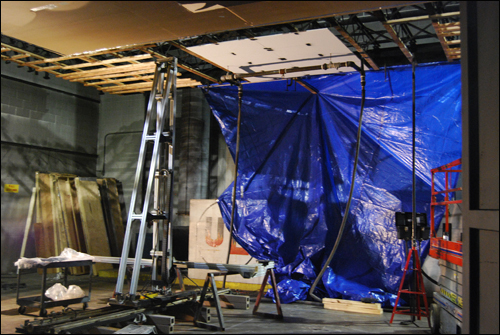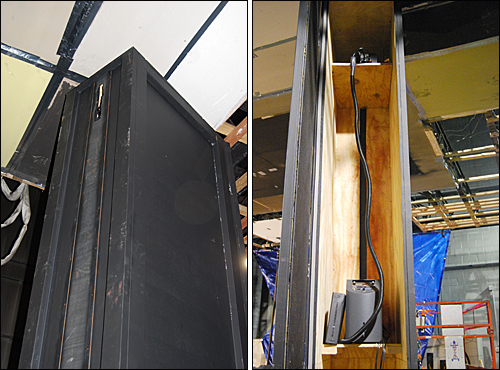Effective and Efficient Fire Streams: Part 2
The first post in this series, Effective and Efficient Fire Streams, discussed theoretical cooling capacity, fire stream efficiency, and flow rate. This post extends the discussion, by examining how nozzle design characteristics and methods of use influence efficiency.
Think!
I do not ask that anyone believe anything that I say (or write in this blog) simply because I said so. Firefightersÿ¢§ opinions about nozzles are as strong as their opinions about what color fire apparatus should be painted and what type of helmet should be used to protect our heads. Each kind and type of nozzle discussed in this post is being used by firefighters all over the world to extinguish fires in buildings. This does not mean that they are all equally effective, or appropriate in all circumstances. I challenge you to think about the physics of fire control and examine your assumptions about nozzles, fire stream characteristics, and how to develop effective and efficient fire streams.
Nozzle Classification
There are several different ways to approach classification of nozzles used in structural firefighting. One simple approach is to consider the pattern or patterns in which water can be applied:
Solid Stream/Smooth Bore: This type of nozzle provides a single pattern consisting of a jet of water that maintains coherence throughout its effective reach (breaking up into extremely large droplets beyond that point)
Combination: This type of nozzle can produce a variety of patterns from a straight stream to a fog cone. Both the straight stream and fog cone are comprised of small droplets of varying diameters. Droplet diameter and consistency of droplet size is dependent on nozzle design and operating pressure (higher pressure results in smaller droplets).
Special Purpose Nozzles: In addition to solid stream and combination nozzles, there are a variety of other specialized nozzles such as piercing nozzles (fog nails), cellar nozzles (of various types), and ultra high pressure solid stream nozzles that can be used for cutting through a variety of materials as well as to produce a fog pattern with extremely small droplets. Specialized nozzles and in particular high pressure and ultra-high pressure systems will be examined in detail in a subsequent post in this series.
Nozzle Characteristics
Beyond simple classification of structural firefighting nozzles as solid stream, combination, or special purpose, nozzles may be further classified based on a number of other characteristics such as the flow rate(s) or flow range and designed operating pressure.
Single Flow: Some nozzles are designed to provide a specific, fixed flow rate at their designed operating pressure. This includes solid stream nozzles with a single sized tip and fixed flow rate combination nozzles. While these nozzles are considered to provide a single flow rate, this is not exactly true. The nozzle orifice is of fixed size, providing a given flow rate at a specified nozzle pressure. As discussed in Under Pressure, flow rate from an opening is based on the area of the opening and the velocity of the water being discharged. Increased or decreased nozzle pressure influences flow rate. For example, increasing the nozzle pressure on a solid stream nozzle from 50 psi (345 kPa) to 80 psi (352 kPa) increases flow rate by approximately 22%.
Variable Flow: Nozzles may also be designed to allow orifice size to be changed, providing variable flow rates at a given nozzle pressure. With solid stream nozzles, this is accomplished by changing the tip size. With some combination nozzles, flow and pattern vary together (e.g., the fog pattern has a lower flow rate than the straight stream setting). However, most modern combination nozzles used for structural firefighting allow adjustment of the spray pattern while maintaining flow rate. Variable flow combination nozzles may be manually adjustable with several different flow rate settings at a specified nozzle pressure.
Automatic Nozzles: Another type of nozzle that allows variation of flow rate is the automatic nozzle. With this design the nozzle adjusts flow rate by varying orifice size automatically to maintain a relatively constant nozzle pressure. With automatic nozzles the flow range specifies the lowest and highest flow rate at the designed nozzle pressure. Some automatic nozzles allow adjustment of the nozzle pressure setting to allow operation at two different nozzle pressures such as 100 psi (690 kPa) and 50 psi (345 kPa).
Nozzle Pressure: At one time the question of nozzle pressure was fairly simple, combination nozzles generally were designed to operate at 100 psi (690 kPa) nozzle pressure. However, today it is not that simple. For a variety of reasons ranging from limited pressure available from high-rise standpipe systems to the desire for lower nozzle reaction force, nozzle manufacturers are producing combination nozzles with varied designed operating pressures (commonly 50 psi (345 kPa), 75 psi (517 kPa), and 100 psi (690 kPa).
Nozzle Performance
Floyd Nelson (1989) captured the essence of nozzle performance in the following statement: ÿ¢§In principle, firefighting is very simple. All one needs to do is put the right amount of water in the right place and the fire is controlledÿ¢§ (p. 102).
Nozzles used for gas cooling must produce small droplets, be capable of varying the angle of the fog cone to have sufficient reach to cover varied sizes of compartments. Droplets with a diameter of 0.3 mm are small enough to vaporize readily in the hot gas layer, but also have sufficient mass to travel a reasonable distance (Herterich, 1960). Droplets larger than 1 mm are likely to penetrate some distance through hot gases and flames without completely vaporizing (Sÿ¢§rdqvist, 2001). In reality, while we know a fair bit about droplet size and performance. We donÿ¢§t know much at all about the droplet sizes produced by the nozzles we are using.
What we do know is that lower pressure nozzles develop larger droplets than higher pressure nozzles of the same general design. Specific design characteristics such as the angle that the water must take as it exits the orifice and forms the fog cone also impact on droplet size. This can be illustrated using a nozzle such as the Akron Turbojet. When set on 30 gal/min (115 l/m) or 60 gal/min and operated at a nozzle pressure of 100 psi, droplet size is extremely small, providing excellent gas cooling performance. However, when flow rate is increased to 95 gal/min (360 l/min) or 125 gal/min (473 l/min) droplet size increases dramatically. While still effective for gas cooling, water application at these flow rates is less efficient.
There is no standardized test used for nozzles that determines the range of droplet sizes produced under different flow rates, nozzle pressures, cone angles, etc. However, there is light at the end of the tunnel. The technology exists to answer this interesting (and I believe important) question. Figures 1 and 2 illustrate a system comprised of lasers and a high speed camera that is used to determine droplet size from sprinkler heads. This system could also be used to assess droplet size developed by handline nozzles (if funding was available).
Figure 1. UL Sprinkler Droplet Size Test Facility

Note: Underwriters Laboratories, Northbrook, IL
Figure 2. Laser and Camera Used for Measuring Droplet Size

Note: Underwriters Laboratories, Northbrook, IL
One factor that complicates things when considering droplet size and nozzle performance is that the nozzle is only one part of the equation. The nozzle operator has a significant influence on performance. For example, in a short pulse, if the nozzle is opened quickly, more of the droplets are formed with the nozzle operating at full nozzle pressure than if it is opened slowly (providing a lower pressure at the start of the pulse). The same is true if the nozzle is closed slowly rather than quickly. This is less significant with long pulses as the opening and closing phase of the pulse comprises a small percentage of the total operating time.
In direct and indirect attack, water must pass through the hot gas layer and reach burning fuel (direct attack) and/or hot surfaces (indirect attack) before significantly evaporating. If distances are not great or the temperature of the hot gas layer is not extremely high, a straight stream or narrow fog cone comprised of small droplets may be effective in accomplishing this task. When gas cooling precedes direct attack, this is often the case. However, if the distance between the nozzle and intended target is large and/or the temperature of the hot gases is high, larger droplets (or a solid stream) may be much more effective.
Selection
Many factors can (and should) be considered when selecting a system to develop effective and efficient fire streams. I used the word system intentionally as a nozzle is useless without hose, a pump, source of water, and most importantly knowledgeable and skilled firefighters to operate it.
The ideal system to develop effective and efficient fire streams for offensive firefighting would have the following capabilities (but not necessarily at the same time).
- Can produce small droplets for gas cooling
- Can produce larger droplets to penetrate hot gases and reach burning fuel or hot surfaces
- Adjustable fog cone angle (allows effective reach in varied size compartments)
- Adequate reach and stream cohesion when adjusted to straight stream
- Ability to vary flow rate depending on fire conditions and tactical application
- Light weight and high level of maneuverability
- Ease of operation to simplify training requirements
At present, it is unlikely that any single system meets all of these requirements (but that is open to debate). Future posts will examine a variety of systems including those that use low, medium, high, and ultra-high nozzle pressure as well as a range of flow rates.
Ed Hartin, MS, EFO, MIFireE, CFO
References
Nelson, F. (1991). Qualitative fire behavior. Ashland, MA: International Society of Fire Service Instructors.
Herterich, O. (1960). Wasser als loschmittel [in German]. Heidelberg, Germany: Alfred Huthig
Sÿ¢§rdqvist, S. (2001). Water and other extinguishing agents. Karlstad, Sweden: Rÿ¢§ddnings Verket.
Tags: Fire Control, nozzle performance, practical fire dynamics



December 21st, 2009 at 05:30
Hello Ed,
At first, congratulations for your blog.
Secondly, sorry but my English is not so good … Þ
Precisions : a real spray (vs theoritical used by computer modeling) is not composed by just one droplet size ; but by several kind droplet size. It exist approximatively more than 10 different terms to defined a droplet size in a real spray !). When you talk about gas cooling, the best mean diameter is Sauter Mean Diameter, also write SMD, d32 or D[3,2]. For solid cooling, the best diameter is surface mean diameter (D2.0).
Example : for the same spray at the same conditions, SMD = 426 çm but SMD = 220 çm.
Concerning the ideal system, I think is not very good to have the possibility to adjust the cone angle. In fluid mecanical, it is possible to obtain a good droplet size diameter (for a given pressure), but change this angle = modify the droplet size of your spray.
I think a ideal system must flushed without a FF intervention, eg : when the FF use is nozzle to fight fire = the nozzle must be have a sufficient free passage.
I hope that in July 2010, this ideal system exists Þ
Fr@+nck
December 21st, 2009 at 05:55
Sorry… un little problem on the example in my first post : “Example : for the same spray at the same conditions, D3.2 = 426 çm but D2.0 =220 çm.
Fr@+nck